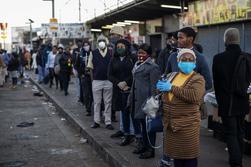 Commuters wearing face masks as a preventive measure against the spread of the coronavirus queue at the Bara taxi rank in Soweto, Johannesburg, on June 1, 2020. (MICHELE SPATARI / AFP)
Commuters wearing face masks as a preventive measure against the spread of the coronavirus queue at the Bara taxi rank in Soweto, Johannesburg, on June 1, 2020. (MICHELE SPATARI / AFP)
An Africa-wide free-trade pact could bolster the region’s income by US$450 billion and lift 30 million people out of extreme poverty by 2035, if accompanied by significant policy reforms and trade-facilitation measures, according to a new World Bank report.
When fully operational by 2030, the region could be the world’s biggest free-trade zone by area, with a potential market of 1.2 billion people and a combined gross domestic product of US$2.5 trillion
While the African Continental Free-Trade Area entered into force legally last year, commerce that was due to have started on July 1 was delayed as the coronavirus pandemic set back protocol negotiations. When fully operational by 2030, the region could be the world’s biggest free-trade zone by area, with a potential market of 1.2 billion people and a combined gross domestic product of US$2.5 trillion.
ALSO READ: Sub-Saharan Africa set for deeper pain from virus, IMF warns
The majority of gains from the pact, equivalent to about US$292 billion, could come from trade reforms, including reducing red tape, lowering compliance costs and facilitating the integration of African businesses into global supply chains, the Washington-based lender said in the report published Monday. Tariff liberalization and rules of origin, which prescribe the share of value that must be added to products in the region to qualify for preferential market access, could make up the balance, it said.
Ivory Coast and Zimbabwe, where trade costs are among the region’s highest, would benefit the most from the agreement, with income set to rise by 14 percent, according to the lender. Intra-continental commerce would increase by 81 percent while shipments to non-African countries would rise 19 percent.
Internal trade accounts for only 15 percent of the total in Africa, compared with 58 percent in Asia and more than 70 percent in Europe. The agreement is meant to help change that by lowering or eliminating cross-border tariffs on 90 percent of goods, facilitating the movement of capital and people, promoting investment and paving the way for a continent-wide customs union.
ALSO READ: Sub-Saharan Africa to fall into recession in 2020, says World Bank
While the planned reduction in duties has raised concerns among countries that rely on them for income, short-term tariff revenues would decline by less than 1.5 percent for 49 out of 54 countries, with total tax revenues set to decrease by less than 0.3 percent in 50 countries, the World Bank said. That’s because only small share of tariff revenues come from intra-African trade and the fact that most revenues comes from a few tariff lines, which would enable some protectionist measures to be maintained even if countries liberalize, it said. The bank sees medium to long-term tariff revenues could rise by 3 percent by 2035.
Fifty-four of the 55 nations recognized by the African Union have signed to join the area, Eritrea being the exception. Twenty-eight nations have ratified the accord.
The pact could help offset the negative impact of the coronavirus on regional trade and value chains by reducing trade costs over the short term, the bank said. It estimates that Africa is likely to lose between US$37 billion and US$79 billion in output due to the outbreak this year.
READ MORE: Africa strives to navigate challenges as cases exceed 10,000
“By replacing the patchwork of regional agreements, streamlining border procedures, and prioritizing trade reforms, AfCFTA could help countries increase their resiliency in the face of future economic shocks,” the bank said.



